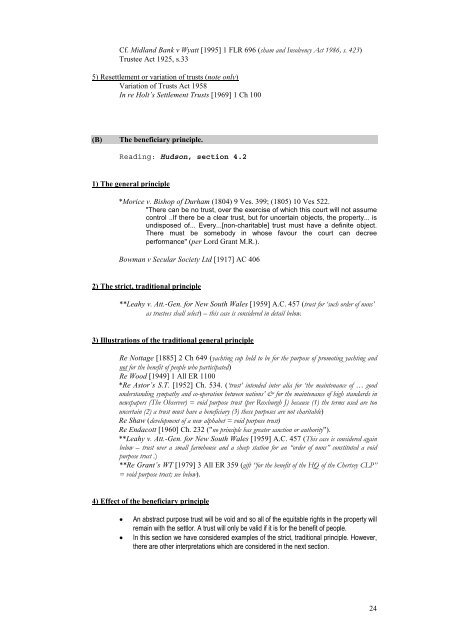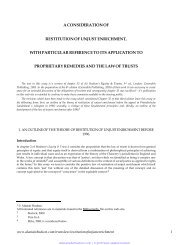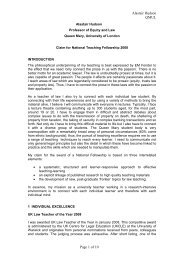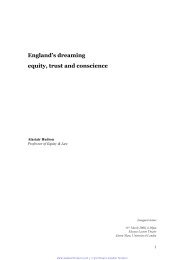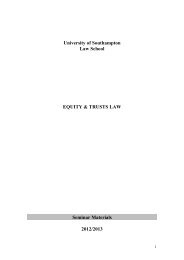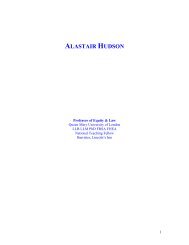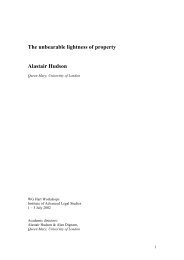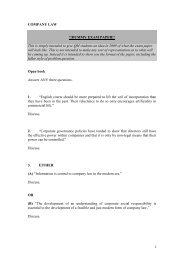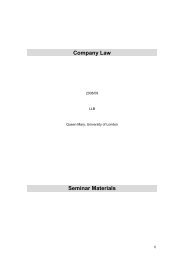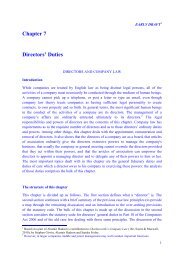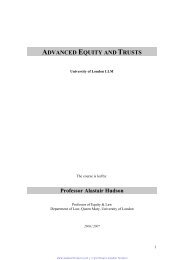Soton Equity and Trusts - alastairhudson.com
Soton Equity and Trusts - alastairhudson.com
Soton Equity and Trusts - alastairhudson.com
Create successful ePaper yourself
Turn your PDF publications into a flip-book with our unique Google optimized e-Paper software.
Cf. Midl<strong>and</strong> Bank v Wyatt [1995] 1 FLR 696 (sham <strong>and</strong> Insolvency Act 1986, s. 423)<br />
Trustee Act 1925, s.33<br />
5) Resettlement or variation of trusts (note only)<br />
Variation of <strong>Trusts</strong> Act 1958<br />
In re Holt’s Settlement <strong>Trusts</strong> [1969] 1 Ch 100<br />
(B)<br />
The beneficiary principle.<br />
Reading: Hudson, section 4.2<br />
1) The general principle<br />
*Morice v. Bishop of Durham (1804) 9 Ves. 399; (1805) 10 Ves 522.<br />
"There can be no trust, over the exercise of which this court will not assume<br />
control ..If there be a clear trust, but for uncertain objects, the property... is<br />
undisposed of... Every...[non-charitable] trust must have a definite object.<br />
There must be somebody in whose favour the court can decree<br />
performance" (per Lord Grant M.R.).<br />
Bowman v Secular Society Ltd [1917] AC 406<br />
2) The strict, traditional principle<br />
**Leahy v. Att.-Gen. for New South Wales [1959] A.C. 457 (trust for ‘such order of nuns’<br />
as trustees shall select) – this case is considered in detail below.<br />
3) Illustrations of the traditional general principle<br />
Re Nottage [1885] 2 Ch 649 (yachting cup held to be for the purpose of promoting yachting <strong>and</strong><br />
not for the benefit of people who participated)<br />
Re Wood [1949] 1 All ER 1100<br />
*Re Astor’s S.T. [1952] Ch. 534. (‘trust’ intended inter alia for ‘the maintenance of … good<br />
underst<strong>and</strong>ing sympathy <strong>and</strong> co-operation between nations’ & for the maintenance of high st<strong>and</strong>ards in<br />
newspapers (The Observer) = void purpose trust (per Roxburgh J) because (1) the terms used are too<br />
uncertain (2) a trust must have a beneficiary (3) these purposes are not charitable)<br />
Re Shaw (development of a new alphabet = void purpose trust)<br />
Re Endacott [1960] Ch. 232 ("no principle has greater sanction or authority").<br />
**Leahy v. Att.-Gen. for New South Wales [1959] A.C. 457 (This case is considered again<br />
below – trust over a small farmhouse <strong>and</strong> a sheep station for an “order of nuns” constituted a void<br />
purpose trust .)<br />
**Re Grant’s WT [1979] 3 All ER 359 (gift “for the benefit of the HQ of the Chertsey CLP”<br />
= void purpose trust; see below).<br />
4) Effect of the beneficiary principle<br />
<br />
<br />
An abstract purpose trust will be void <strong>and</strong> so all of the equitable rights in the property will<br />
remain with the settlor. A trust will only be valid if it is for the benefit of people.<br />
In this section we have considered examples of the strict, traditional principle. However,<br />
there are other interpretations which are considered in the next section.<br />
24


